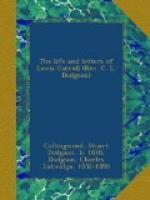[Illustration: Facsimile of a letter from Sir John Tenniel to Lewis Carroll, June 1, 1870.]
“Through the Looking Glass” has recently appeared in a solemn judgment of the House of Lords. In Eastman Photographic Materials Company v. Comptroller General of Patents, Designs, and Trademarks (1898), the question for decision was, What constitutes an invented word? A trademark that consists of or contains an invented word or words is capable of registration. “Solio” was the word in issue in the case. Lord Macnaghten in his judgment said, when alluding to the distinguishing characteristics of an invented word:
I do not think that it is necessary that it should be wholly meaningless. To give an illustration: your lordships may remember that in a book of striking humour and fancy, which was in everybody’s hands when it was first published, there is a collection of strange words where “there are” (to use the language of the author) “two meanings packed up into one word.” No one would say that those were not invented words. Still they contain a meaning—a meaning is wrapped up in them if you can only find it out.
Before I leave the subject of the “Looking-Glass,” I should like to mention one or two circumstances in connection with it which illustrate his reverence for sacred things. In his original manuscript the bad-tempered flower (pp. 28-33) was the passion-flower; the sacred origin of the name never struck him, until it was pointed out to him by a friend, when he at once changed it into the tiger-lily. Another friend asked him if the final scene was based upon the triumphal conclusion of “Pilgrim’s Progress.” He repudiated the idea, saying that he would consider such trespassing on holy ground as highly irreverent.
He seemed never to be satisfied with the amount of work he had on hand, and in 1872 he determined to add to his other labours by studying anatomy and physiology. Professor Barclay Thompson supplied him with a set of bones, and, having purchased the needful books, he set to work in good earnest. His mind was first turned to acquiring medical knowledge by his happening to be at hand when a man was seized with an epileptic fit. He had prevented the poor creature from falling, but was utterly at a loss what to do next. To be better prepared on any future occasion, he bought a little manual called “What to do in Emergencies.” In later years he was constantly buying medical and surgical works, and by the end of his life he had a library of which no doctor need have been ashamed. There were only two special bequests in his will, one of some small keepsakes to his landlady at Eastbourne, Mrs. Dyer, and the other of his medical books to my brother.
Whenever a new idea presented itself to his mind he used to make a note of it; he even invented a system by which he could take notes in the dark, if some happy thought or ingenious problem suggested itself to him during a sleepless night. Like most men who systematically overtax their brains, he was a poor sleeper. He would sometimes go through a whole book of Euclid in bed; he was so familiar with the bookwork that he could actually see the figures before him in the dark, and did not confuse the letters, which is perhaps even more remarkable.




